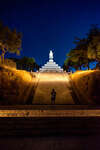Place d'Austerlitz - Ajaccio
To make the place speak through light and images, to focus the perspective on the central tragedian, to stage the heritage scene, to unite the near and the far (spatial and temporal)
In photos
In detail
The Place d'Austerlitz and the Napoleon grotto, more commonly known as the Casone ("U Casonu"), constitute a memorial site dominated by the imposing statue of Napoleon I, erected in 1935 by Emile Seurre.
The lighting strategy is part of a historical, cultural and patrimonial enhancement approach aiming at prolonging and reaffirming the singularity of this place by night and in no way denaturing it.
The new nocturnal identity has been conceived along three main lines: respecting the morphology of the Casone and the statue of Napoleon, redesigning the structural elements of the esplanade and the various adjoining spaces, and proposing an intimate atmosphere in the Napoleon grotto as well as warm lighting for the pedestrian walkways.
The lighting proposals highlight the fullness and emptiness, the horizontality of the square as well as the intimacy of its small spaces (grottoes, pathways, seats, etc.), and allow for a quick reading of the conceptual proposal by playing with the ubiquity of near and far visibility. All the lighting is perfectly integrated into the landscape.
The esplanade is lined with large poles designed to free the central space from any emergence so as not to interfere with the contemplation of the statue, on the one hand, and not to interfere with potential event activities, on the other.
The surface of its floor is covered with projections of images relating the history of the place and its guardian (Napoleon). The illustrations were created by Valérie Santarelli, a specialist in Napoleonic legend. They are inspired by the artistic style known as "silhouette portraiture" (also known as "shadow art"), stylized and worked around a contour line drawn from a shadow projected on a body or subject.
The statue of Napoleon, positioned as a "tragedian in the background" is the central and identifying element of the square. It therefore benefits from lighting that is sufficiently precise to reveal it, but also diffuse and directional, in order to give sight while preserving a part of mystery...
The new equipment allows the implementation of evolving lighting scenarios, depending on the time of year or specific events related to the place.






